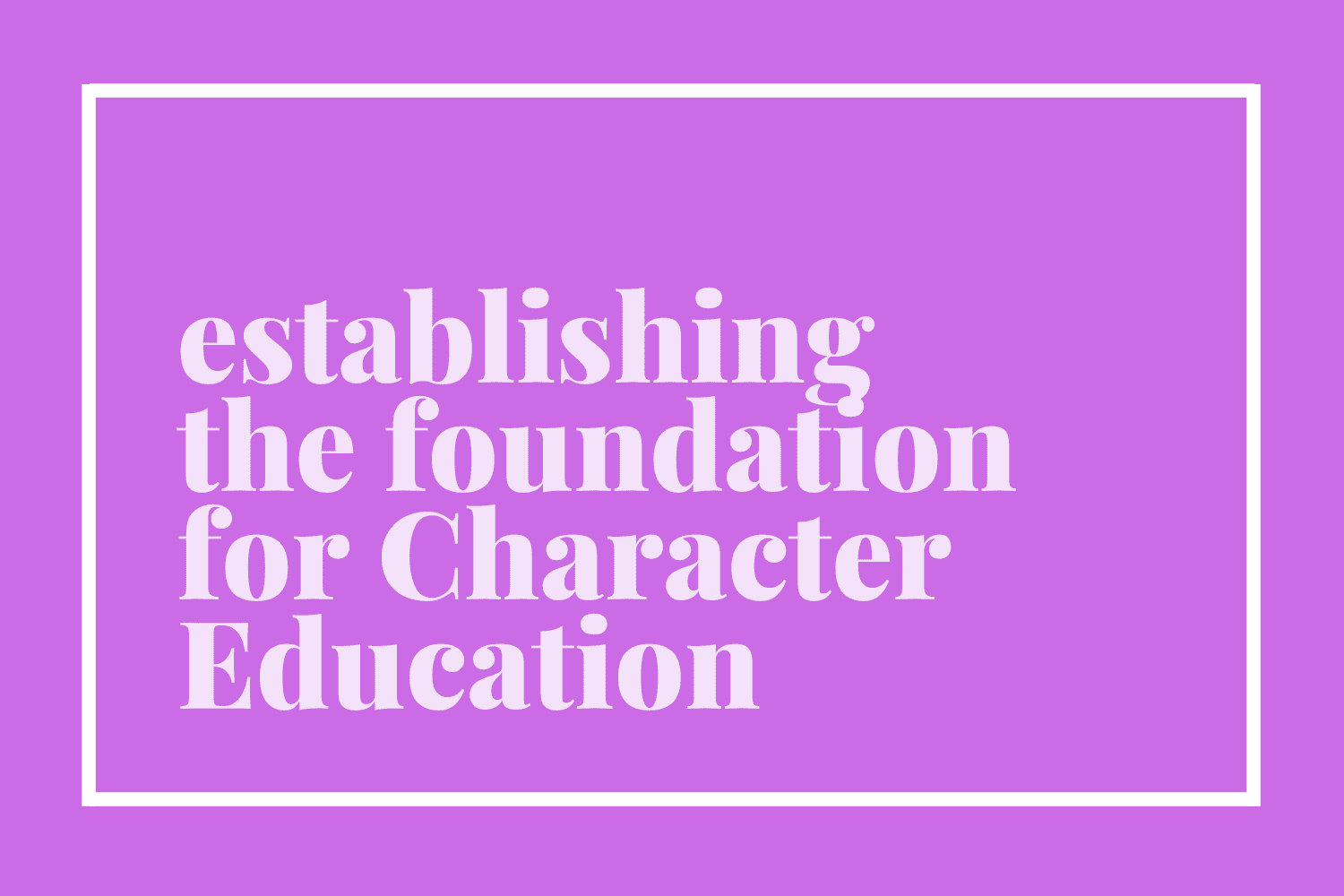
The Way
Leading is about becoming a servant who goes on a journey from me to you to us through asking the question: how can I best serve others? Leading in a school community begins with understanding the mission and its tasks, developing a shared vision for how strategic learning capacity might be increased, and answering the questions that will help the school make the right choices about its future.

LEADING FOR AND WITH CHARACTER
School leaders build character capital in a school community through their character labour, especially through role modelling and development of character competency; the efficacy of an education for character, competency and wellness results from their will and their capacity to embed a shared commitment to ‘what we want, why we want it and how we do it’ in the whole work of a School for tomorrow.
Building character capital is a key role of civic, performance, and moral character leadership. Character capital relates particularly to the value of the feelings and perceptions held by the school and wider communities about the character purpose and character strengths of a school. It is, therefore, inherently moral in nature. It externalises the shared purpose of relationships. It also builds personal value in terms of the level of positive, focused energy about character and character education that leaders invest at work and in their personal life. It also internalises the alignment of hearts and heads. The value of families’ character commitments is held in the hearts of the people within a school. It can be seen in the energy and enthusiasm that people bring to support and act upon the values and character strengths of the school.
Character leadership in practice is inspired by example. We believe that currently, character leaders in schools typically have a clear picture of the daily character work, and that the nature of this work should correspond to how the work of other character educators is located within their schools. Nonetheless, there seems little opportunity for them to reflect on how this work can be situated within a model or series of models that allow for the development of a cogent theory of character leadership. Such modelling at a theoretical is essential for them to build a consistent, high quality culture of practice in character leadership throughout their school.
Character leadership in practice can be improved by linking it to a theory that explains the decisions that drive this practice. We believe that character leadership is currently envisaged more in the daily doing, perhaps itself a by-product of the busy-ness to which most leaders would point, if they had the time to comment! If character leaders do find the time to reflect and develop a model of practice, any model that they construct for themselves about their leadership, therefore, might benefit from a clear alignment to the strategic educational intent of being a fit for purpose 21C school of character, and operational soundness in implementation of a plan to attain this intent. It must include the development and promulgation of a compelling narrative that helps school members to understand where the journey is taking them and why it is necessary for them to join in to the collective enterprise. Part of this narrative needs to model change in perspective and growth in capability for all. This needs to encourage the contribution of all to the evidence-based community of inquiry and practice that will act as the knowledge engine for the school moving forwards. Finally, it requires leadership by example that is connected to the core of the school’s ethos and a willingness to undergo scrutiny of the effectiveness of this example.
This process of leading the character work in a school must start with us. We need to investigate our understanding of what it means to be an educator: what we hope to do, how we hope to do it and why we hope to do it. Through this self-reflection and interrogation of the alignment of Our Purpose, Our People, Our Place and Our Practice, we will reach a more complex and rich understanding of our intention and purpose for the benefit of our students, our peers and communities. The responsibility we have and the standards we hold ourselves to must come from within. Through this, we can become more than just educators of knowledge, and move towards playing the most important role in developing our students into citizens who can change the world for the better.
We can then begin to investigate the most effective ways to sponsor character, culture and change within our classrooms. Becoming a leader is more than just being an example or professing the traits and behaviours of a good person. It is about integrating ourselves within the teacher and student communities of inquiry and practice and understanding the needs and ambitions of our peers and community in order to be the proponents of a growth-minded change culture within an education for character, competency and wellness. It is not limited to one space within school nor is it limited to one form of practice. It takes place in all areas of school and it must be our own.
Ultimately, our role as educators is far more important than any one action or process that takes place in the classroom. Our students and our communities look to us to exemplify the behaviours, traits and actions that are exemplary of what it means to be a good person. We have the opportunity to build meaningful and impactful relationships in our day-to-day work that can change our students’ lives for the better. Leading is the process of accepting this responsibility, growing to understand it, and being confident enough to action it within our lives as educators.
“If your actions create a legacy that inspire others to dream more, learn more, do more and become more then you are an excellent leader.”
Dolly Parton
BUILD THE FOUNDATIONS FOR AN EDUCATION OF CHARACTER, COMPETENCY AND WELLBEING
There are six corridors along which we might walk to develop an understanding of 21C character and competency. We believe that six corridors form the essential knowledge architecture of 21C character education. Through them, we can track (in the first instance) the realisation of graduate outcomes in key qualities and competencies grounded in the four integrated dimensions of knowledge, skills, character, and learning habits:
- A good person of integrity who exercises strong and positive character
- A future builder who uses communication competency to navigate and interpret complexity
- A continuous learner and unlearner who is focused on growth has mastery of change readiness
- A solution architect whose direction is revealed by their use of creative and critical thinking
- A responsible citizen who balances the competing demands of local, regional and global communities with perspective
- A team creator who demonstrates relationality most tangibly through collaboration
The development of the whole person within these corridors of The Pathway to Excellence relies on most significantly on relationship. The quality of learning for character, competency and wellness in a school is largely the product of both specific learning relationships of character apprenticeship in which competency is crafted, and also the way that those relationships bring together all learners in a community of inquiry and practice that is sharply focused on improving delivery of the school’s graduate outcomes.We see character apprenticeship as a progression from articulation to reflection to exploration as a novice, then from modelling to coaching to scaffolding as an expert. It is a strong and yet non-judgmental way of explaining how a student learns about character in relationship with others. Our model of character apprenticeship emphasises the importance of teaching and leading others on the road to mastery of character competency as a feature of character education itself. In other words, there must be a deliberate pedagogical shift in the power dynamic of the learning relationship as the expert hands over the opportunity to teach others to those who were once their novices and are now experts in their own right. We also think that the movement from novice to expert is not necessarily linear, nor does it preclude a learner being both simultaneously. We see from the evidence in schools globally that many supposed experts still regard themselves as being learners who are also benefiting from being in relationship with those whom they consider to be greater experts.
THE GROWTH OF THE COMMUNITY OF INQUIRY AND PRACTICE
An education for character competency and wellbeing in a School for tomorrow. works best when it’s deliberate, targeted, and intentional. The consistency of character learning in a school is a reflection of a school’s willingness to embrace the need for strategic educational development that embeds 21C character and competencies into every facet of school life in a deliberate, targeted and intentional way. This requires the adoption of a strategic approach to building the right learning culture, as well as the collaborative development of a conceptual and documentary framework for education that will help a school move beyond being just intentional to becoming a school of character in every respect.
Asking the right questions shifts us from defending the status quo to seeking what is best for our students. We believe that as a community of inquiry and practice, the preparation of the strategic educational approach required to embed 21C character and competency within a school begins with asking the right questions. Strengths and gaps need to be identified. The commitment of all members of the school community to base future educational development activity on the evidence gained in response to these questions is essential. Prevailing assumptions and existing habits need to be interrogated for their continuing relevance. In other words, a community of inquiry and practice must be prepared to inquire, to dig deep, and to confront the challenge of relevance when the natural inclination of many will be to default to a status quo.
A documented Framework for Education provides the direction and structure required to make real the intentionality of most schools to prepare their students to thrive in their world. We believe that building an agreed and documented Framework for Education needs to be recognised as the important first step of a whole community of inquiry and practice that aspires to deliver an excellent 21C education. It needs to flow from agreed graduate outcomes for character and competency that the community most wants to see as the essential product of their educational program. Educational activity that operationalises this strategic intent all needs to be aligned to this purpose and its associated language. In this way, a school can begin to think even more deeply about (and pursue with greater rigour) what it is trying to achieve for its students beyond externally-mandated curricula and other activities. In this way, it might create a deliberate, targeted, and intentional program of character learning that is coherent, supported by evidence-based practice, and more likely to achieve better outcomes for more learners.
Standards for character education hold everyone to their educational purpose. In seeking to set and attain high standards, we must be able to define excellence. Something that is excellent is of the highest quality. It achieves the highest level of performance; it is exemplary. In doing so it exceeds normal expectations of performance and meets the highest expectations of what can be achieved. Ultimately, a school with a strong culture of excellence is not merely good, it sets the standard to be followed, and it is something of great virtue and worth – it is excellent. Excellence in anything starts with a vision, will and passion. The process for preparing a community to cultivate these includes:
- Understanding the context: Responding to historical perspectives of and contemporary provocations for excellence in learning through character, competency and wellness
- Defining the culture: Constructing a vision, rationale, standards, norms, and narrative for achieving excellence in educational processes and outcomes
- Cultivating the passion: Building alignment through aspirations for excellence, structural cohesion, cultural robustness, and collaboration through inquiry and practice
We believe there are six desired graduate outcomes based on 21C civic, performance, and moral character competencies that can define the standards that can help a school to identify, understand and agree on a shared vision and Framework for Education:
- A good person of integrity who exercises strong and positive character
- A future builder who uses communication competency to navigate and interpret complexity
- A continuous learner and unlearner who is focused on growth and has mastery of change readiness
- A solution architect whose direction is revealed by their use of creative and critical thinking
- A responsible citizen who balances the competing demands of local, regional and global communities with perspective
- A team creator who demonstrates relationality most tangibly through collaboration
Any set of standards are probably best seen as a useful starting point for a school to consider what it most wants to achieve. Most (if not all) schools should want some point of reference to what might be considered an industry standard. It is preferable for schools to work through what they want the qualities and capabilities of their graduates to be and how they want this to work through into the learning of their students along the pathway towards graduation. Each school has its own context and heritage that will influence the priorities that their community will wish to afford certain aspects of the character for a 21C life and the nuances of how this will play out in their own educational space. Off-the-shelf, in this respect, is neither wanted nor preferred. This will mean that a School for tomorrow. will need to develop their own approaches to formulating both the content and course of an education for character, competency and wellness that prepares their students to embark on The Pathway to Excellence with success.

ESTABLISHING THE FOUNDATIONS FOR CHARACTER EDUCATION
Character education works best when it’s deliberate, targeted, and intentional. The consistency of character learning in a school is a reflection of a school’s willingness to embrace the need for strategic educational development that embeds 21C character and competencies into every facet of school life in a deliberate, targeted and intentional way...

LEADING FOR AND WITH CHARACTER
School leaders show the way forward. School leaders build character capital in a school community through their character labor, especially through role modelling and development of character competency; character education efficacy results from their will and their capacity to embed a shared commitment to ‘what we want, why we want it and how we do it’ in character education...

ASKING THE RIGHT QUESTIONS
Asking the right questions shifts us from defending the status quo to seeking what is best for our students. We believe that as a community of inquiry and practice, the preparation of the strategic educational approach required to embed 21C character and competency within a school begins with asking the right questions. Strengths and gaps need to be identified. The commitment of all members of the school community to base future educational development activity on the evidence gained in response to these questions is essential...

BUILDING CHARACTER CAPITAL
Building character capital is a key role of civic, performance and moral character leadership. We believe that character capital relates particularly to the value of the feelings and perceptions held by the school and wider communities about the character purpose and character strengths of a school. It is, therefore, inherently moral in nature. It externalises the shared purpose of relationships. It builds personal value in terms of the level of positive, focused energy about character and character education that leaders invest at work and in their personal life.

A DOCUMENTED FRAMEWORK FOR EDUCATION
A framework for education provides the direction and structure required to make real the intentionality of most schools to prepare their students to thrive in their world. We believe that building an agreed and documented framework for education needs to be recognised as the important first step of a whole community of inquiry and practice that aspires to deliver an excellent 21C education. It needs to flow from agreed graduate outcomes for character and competency that the community most wants to see as the essential product of their educational program...

CHARACTER LEADERSHIP IN THEORY
Character leadership in practice can be improved by linking it to a theory that explains the decisions that drive this practice. We believe that character leadership is currently envisaged more in the daily doing, perhaps itself a by- product of the busy-ness to which most leaders would point, if they had the time to comment! If character leaders do find the time to reflect and develop a model of practice, any model that they construct for themselves about their leadership, therefore, might benefit from a clear alignment to the strategic educational intent of being a fit for purpose 21C school of character...

STANDARDS FOR CHARACTER EDUCATION
Standards for character education hold everyone to their educational purpose. We believe that we have reached the point now where we might successfully assemble the six corridors of an set of standards that can help a school to identify, understand, and agree on a shared vision and framework for education that is aligned to desired graduate outcomes based on 21C civic, performance, and moral character competencies. Nonetheless, these proposed standards are probably best seen as a useful starting point for a school to consider what it most wants to achieve...

CHARACTER LEADERSHIP IN PRACTICE
Character leadership in practice is inspired by example. We believe that currently, character leaders in schools typically have a clear picture of the daily character work and that the nature of this work should correspond to how the work of other character educators is located within their schools. Nonetheless, there seems little opportunity for them to reflect on how this work can be situated within a model or series of models that allow for the development of a cogent theory of character leadership...